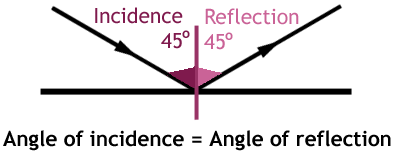
Likewise, in the reverse case, because the optical density of the medium is reversed, there is no $\theta_c$. Past the critical angle $\theta_c + d\theta$, all the light is reflected. At this point you can imagine the majority of the light would be reflected and only a small percentage of light is refracted.Īt the critical angle $\theta_c$, although the refracted angle is tangent to the surface, the intensity is actually 0, and all the light is being reflected.

Very near the critical angle $\theta_c - d\theta$, likewise, some of the light will be transmitted (refracted almost tangent to the surface) and some will be reflected. If the light ray is normal to the surface, the maximum amount of light is transmitted.Īs the light ray bends, as in your part (b), a percentage of the light will be transmitted (refracted) and the remaining will be reflected (at the incidence angle). It is basically responsible for making your microprocessor work and your internet reach your home :) The evanescent wave phenomenon is widely used in photonics: waveguide coupling, fiber optics transmission, ellipsometry, etc. There are other consequences at the microscopic scale, like the Goos-Hanchen effect: the reflected wave is slightly shifted parallel to the surface. It exists only within a few microns from the interface and decays exponentially (If you are familiar with partial differential equations, the solution has an imaginary propagation constant). It is just not propagating, and is called evanescent. BUT, there is still an EM field that goes through the interface. No light transmitted means that there is no viable propagating solution to the Helmholtz equation in the exiting medium. Above the critical angle, the phenomenon is called Total Internal Reflection (TIR).For air to glass interface, about 4% of the light is reflected at normal incidence (just look at your reflection in a window). There is always some amount of reflection, even when the incident angle is below the critical angle. There are 2 consequences you might be interested in: They describe the amplitude (and phase) of the reflected and transmitted beams. figures in s answer) as a function of the angle of incidence. It gives the reflected and transmitted electric and magnetic components as a function of the refractive indices of the incident and exiting media.įrom those solutions we can derive the Fresnel transmission and reflection coefficients (cf. The behavior of light at an interface is described by the electro-magnetic field solution to the Helmhotlz equation. So is the teacher wrong? Where lies the fallacy? If (a) is occurring, which should occur according to my teacher, then it contradicts principle of reversibility, or actually common sense, since the reverse ray won't even touch the surface, and if (b) occurs then it contradicts what my teacher taught me.

I have given the options which should occur in the picture, (a) and (b), with (a) being wha my sir said and (b) being the other option. But the above concept my sir taught kinda contradicts for part (a). For the (b) part I saw this ( Does light reflect if incident at exactly the critical angle?) question. Sorry for my bad drawing, but as you can see, my question is that what happens when I make the ray incident at (a)almost equal to critical angle (i limiting to $i_c$) and (b) at exactly $i_c$. And the main doubt emerges when I make the scenario given in the picture below: First of all, I'm not sure about the above and would like a bit clarity on this. The question arose when my physics teacher taught me geometrical optics and told that the phenomenon of both refraction and $reflection$ occur by change in medium.


 0 kommentar(er)
0 kommentar(er)
